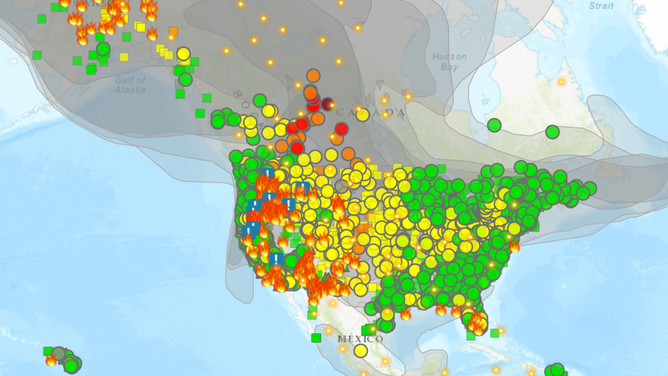See it: Oregon now battling country’s largest 'megafire'
According to experts at NOAA, a megafire is a blaze that burns more than 100,000 acres and produces wide ranging societal impacts. According to the National Interagency Fire Center, at least five fires burning through the West have consumed more than 100,000 acres.
Firefighters battle dozens of wildfires in the western U.S.
The Durkee Fire in eastern Oregon has burned around a quarter of million after lighting started the blaze around July 17.
PORTLAND, Ore. – A wildfire raging in eastern Oregon has doubled in size, making the blaze the largest wildfire in the country firefighters have worked to contain so far this year.
According to the latest report from the U.S. Department of the Interior, the Durkee Fire has scorched nearly a 300,000 acres since it was ignited by a lightning strike on July 17.
WILDFIRE SMOKE POURS ACROSS AMERICA BRINGING HAZE FROM COAST TO COAST
Erratic winds and dry brush are reported to be fueling its rapid spread, which has forced evacuations around Durkee, Oregon and the temporary shutdown of Interstate 84.
So far, no structures have been reported to have been destroyed, but a contingent of more than 500 personnel assigned to fire are in structure protection mode in the areas of Burnt River, Rye Creek, Brogan, Willow Creek and Vale.
EVACUATIONS EXPAND AS WILDFIRE BURNING NEAR CHICO, CALIFORNIA, EXPLODES IN SIZE
The blaze is one of at least five across the western U.S. that have burned more than 100,000 acres and is known as a "megafire."
NOAA forecasters widely define any fire that has burned at least 100,000 acres and is producing societal impacts as a "megafire."

(FOX Weather)
POLLUTION FROM CALIFORNIA WILDFIRES KILLED 52,000 IN A DECADE, STUDY SAYS
Other large fires include the McDonald Fire in Alaska, the Falls and the Lone Rock fires in Central Oregon and the Cow Valley Fire in the eastern region of the state.
The McDonald Fire burning outside Fairbanks, Alaska, was the nation’s largest fire, holding the status for the most acres burned for a majority of the summer.
The fire began in early June, and firefighters said the blaze is believed to have started with a lightning strike.
At the last report, more than 172,000 acres were believed to have burned, but damage to structures has been limited to the blaze’s rural nature.
The combination of hundreds of wildfires burning across the Last Frontier, western Canada and the U.S. West has impacted air quality readings, with some observation sites reporting unhealthy levels of particulates.
The fire season typically peaks in Canada during June and July but lingers longer into the year in the Lower 48.

Air Quality map showing an extensive layer of smoke over North America
(AirNow / FOX Weather)
WESTERN WILDFIRES GROW AMID HEAT WAVE, INCREASING DROUGHT
Wildfire activity is not atypical
Despite the apparent flurry of activity, the number of fires compared to the year-to-date average is actually down around 20% for the year.
Data from the NIFC shows that slightly more than 26,000 fires have been reported to the agency, while the average year-to-date number is typically more than 32,000 fires.
While the year-to-date fire counts are below normal, the number of acres burned across the nation is above average, primarily due to the Smokehouse Creek Fire in Texas and Oklahoma that occurred during the spring.
This human-caused fire accounts for nearly a third of the nation’s burned acreage. Including this record-breaking fire, the NIFC reports that 3.6 million acres have been destroyed, which is slightly more than the average of 3.4 million acres year-to-date.
Without the inclusion of the Smokehouse Creek Fire, the number of acres burned would be comparable to the count of wildfires, down about 20% when compared to average.




